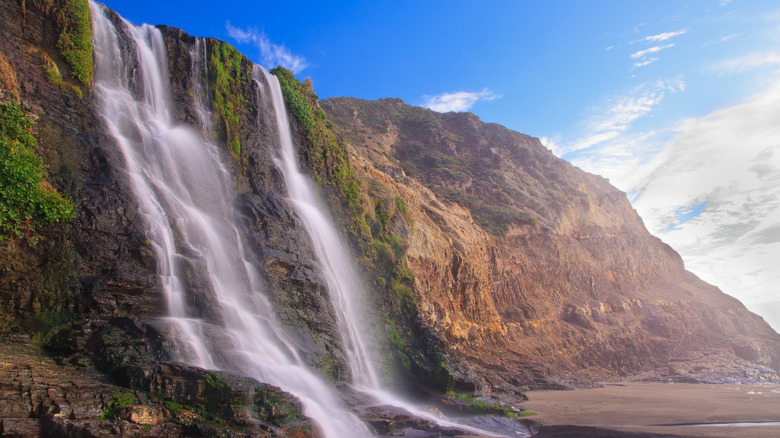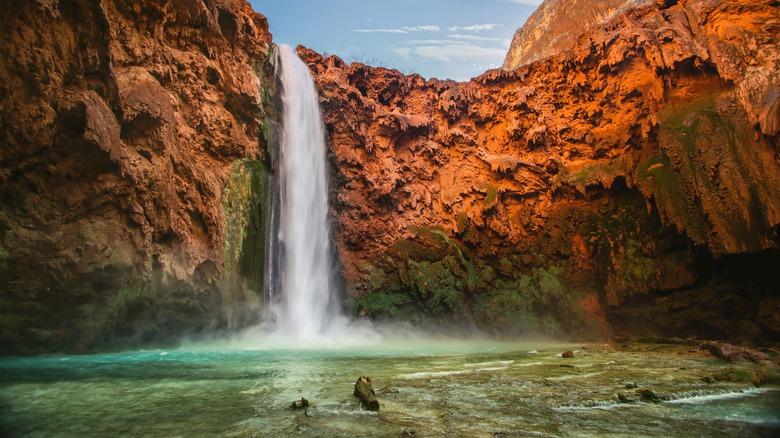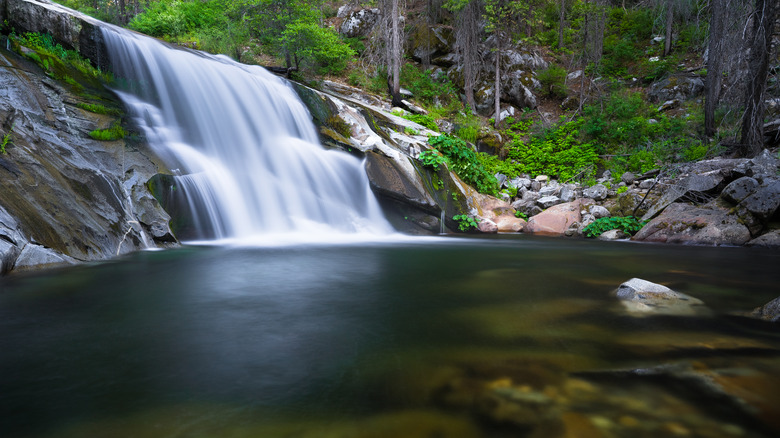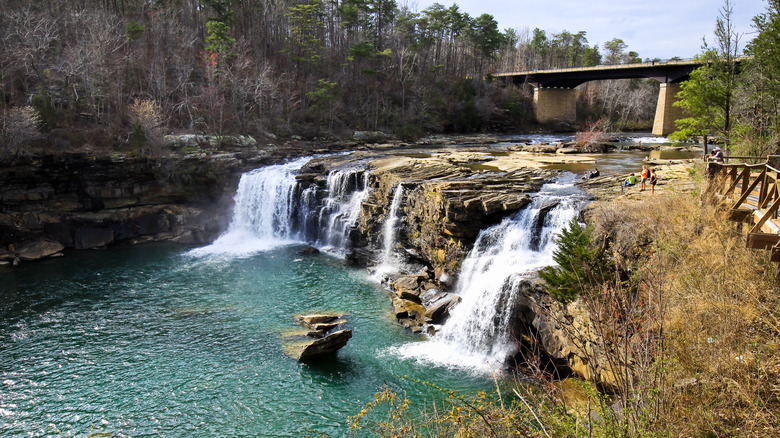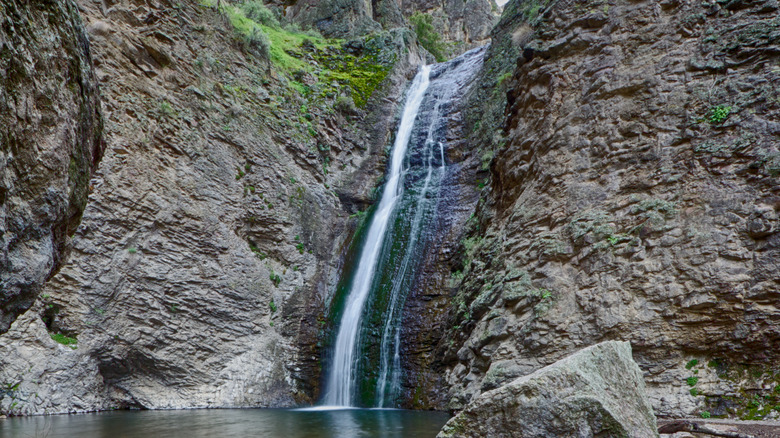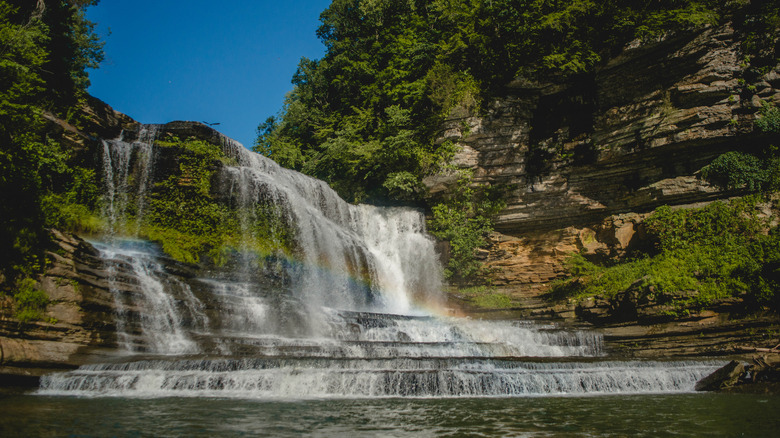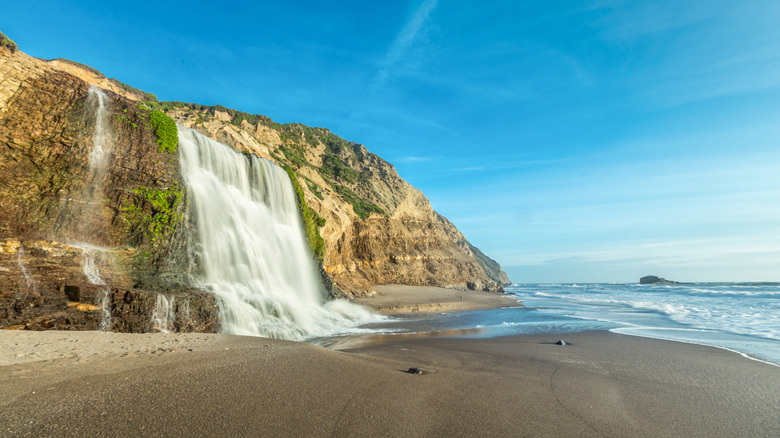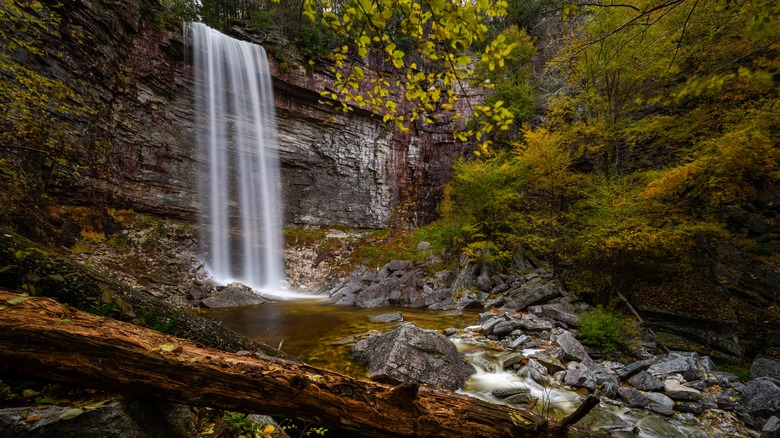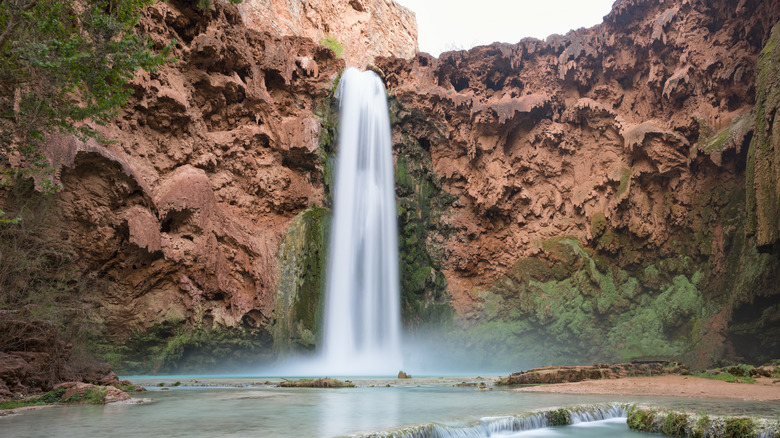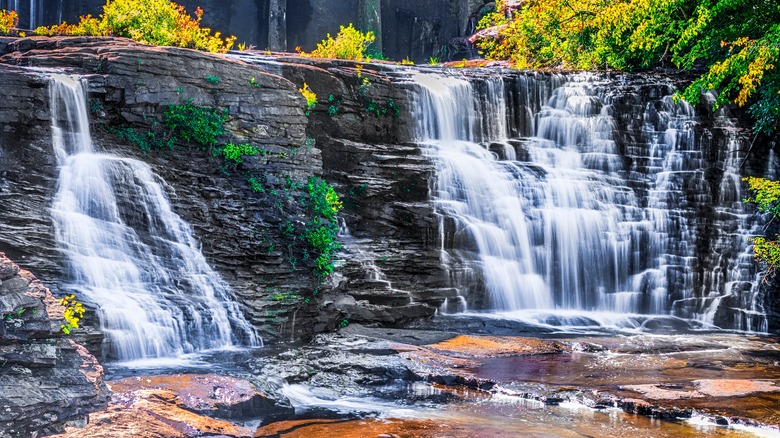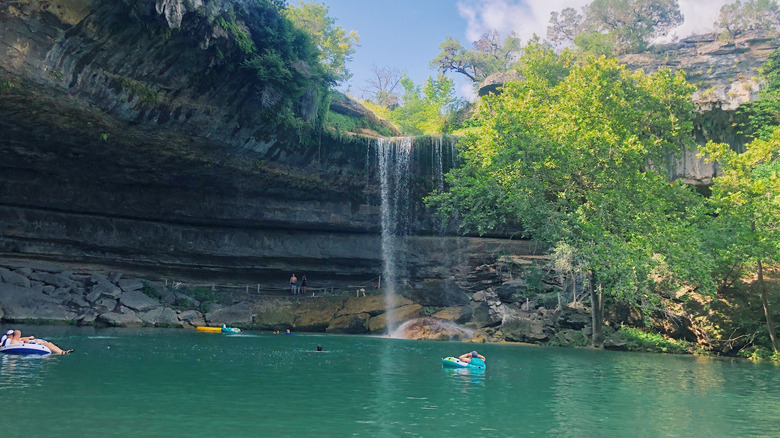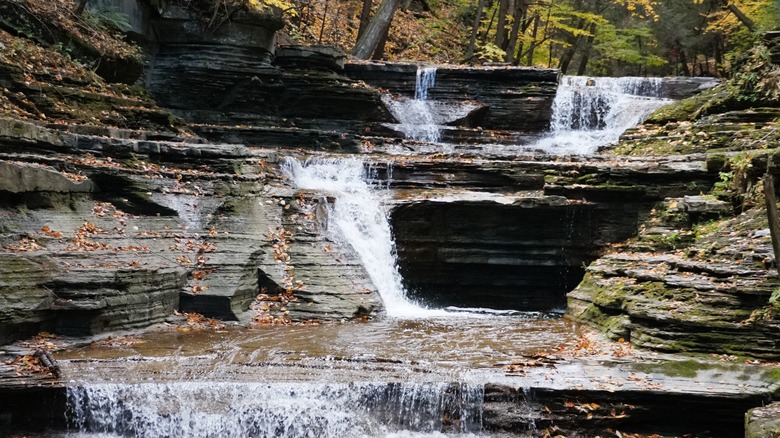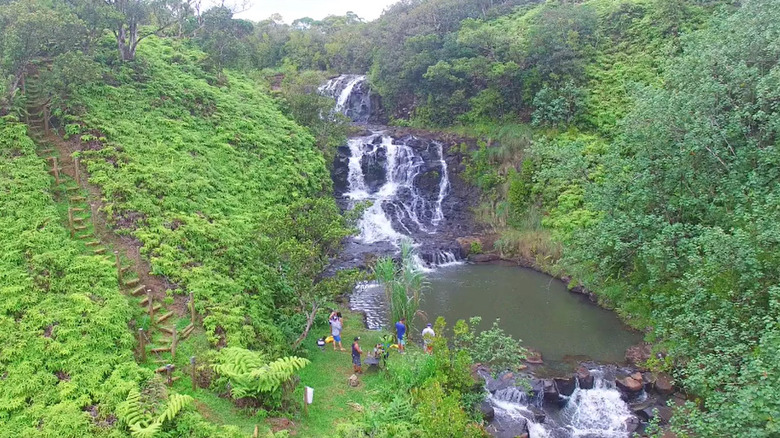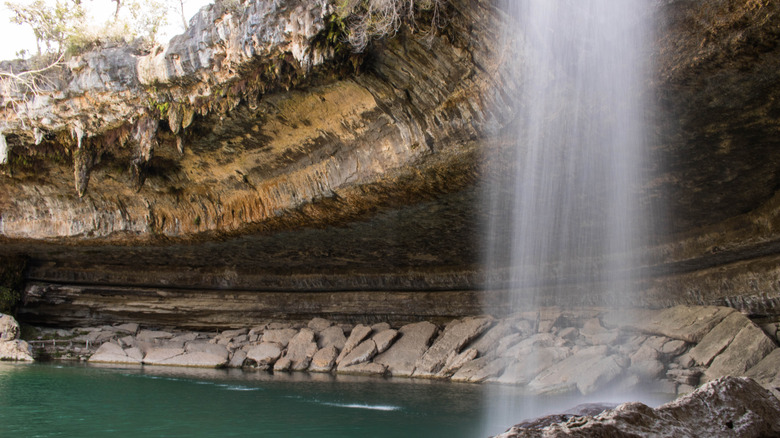12 Beautiful Waterfalls In America You Can Swim In
It's one thing to look at the natural, calming, yet powerful flow of a waterfall, but it's another thing to swim in one. That's where these beautiful falls throughout America come in. Many of these waterfalls have been popular places to cool off for centuries. Not only can you grab a wow-worthy Instagram photo, but you can also feel the mineral-enriched waters for yourself. That doesn't mean the experience is always a walk in the park. To reach some of these waterfalls, you'll need to hike upwards of 10 miles, often through rocky and uncertain terrain, and even camp.
That said, we've done the prep work for you by assembling this list of stunning waterfalls you can swim in. To create this list, we researched some of the country's most beautiful waterfalls through their associated park websites, hiking blogs, and travel guides to determine which waterfalls throughout America are perfect for soaking it all in on hot spring and summer days.
Havasu Falls, Arizona
Nothing worth having comes easy, and that couldn't be truer when it comes to Havasu Falls, a famously blue-green, 100-foot waterfall that most people have seen before on a screen. It's one of the most beautiful places in America's state and national parks. But seeing Havasu Falls in person is much more difficult than unlocking a computer screen or flipping a calendar. Only experienced hikers should attempt the rugged hike to get to it, and they'll first need to obtain a permit as well as an overnight campsite or lodge reservation. Permits for the year are made available on February 1. If you're not a camper, experienced hiker, or open to basic lodging, which offers beds but no phone service or television, you may be able to book a helicopter trip to Havasu Falls.
But once you reach the falls, it's all about the water, which maintains its rich color from the calcium carbonate and magnesium present in the spring waters that flow to the falls. It's on the Havasupai Indian Reservation, near Grand Canyon National Park, and Havasupai means "people of the blue-green waters." Although you might think that summer would be the best time to take a dip, this season can actually be the worst, since temperatures in the area can reach a smoldering 115 degrees Fahrenheit, and the trail can close due to flooding. Instead, head here in the spring or fall when temperatures are moderate.
Carlon Falls, California
If you're not a fan of extreme hikes like the one that leads to Havasu Falls, Carlon Falls in Yosemite is a great alternative. It offers the scenic waters of the South Fork of the Tuolumne River but will take you less than two miles to hike here, and you don't need to be Lewis and Clark to traverse it. Even better, the easy, smooth hike is surrounded by plenty of beautiful foliage like wildflowers, ferns, and Indian rhubarb. The trail starts in Stanislaus National Forest before it enters Yosemite National Park, where the falls are located.
Carlon Falls is surrounded by several smaller waterfalls before pooling at the bottom, making for the perfect place for a dip. But depending on when you visit Carlon Falls, your experience may vary. During the springtime, the waters can be high and rough, but from summer through fall, the calmer waters may attract larger crowds. For the best experience, consider visiting from summer through fall on a weekday early or later in the day.
Little River Falls, Alabama
Little River Canyon National Preserve is home to Little River Falls, which is the most popular of the preserve's three waterfalls, and you won't need to venture far to find it. The 45-foot-high waterfall is near the Little River Canyon Visitor Center and will be one of the first things you see when you get to the preserve — if you get here early enough to park in the parking lot, which is often full by 11 a.m. on late spring and summer weekends.
But a visit here means you get a three-for-one deal, as you can also see Little Falls. This is a great place to swim after hiking about three-quarters of a mile and walking down a set of 137 stone steps from the parking lot. Depending on the season and rainfall levels, you can also see the 133-foot-high Graces High Falls, which is the tallest waterfall (above ground) in the state.
The summer is the best time to visit Little River Falls. Temperatures are ideal for swimming, and the water level in the pools is lower and safer. If you opt to swim when the water is higher, do so with caution, as despite the falls' beauty, it's been the site of many rescues and drownings. To keep tourists safe, no one is allowed, per law, within 50 feet of the edge of the falls.
Jump Creek Falls, Idaho
The rocky terrain and desert brush can't hide a waterfall as majestic as Jump Creek Falls in Idaho. It takes just a quarter-mile hike to reach the falls, but the hike's difficulty depends on whether you want to see the falls from the top or bottom. If you want to see them from the top, then ensure that you're no beginner hiker and take the upper trail, which winds along the canyon's brink. But if you want to swim in the pools of the falls and hang out in a shallow cave, then take the easier lower trail. To note, the lower trail can be wet and requires crossing a stream atop a few rocks.
But it's all worth it to enjoy an afternoon at the 60-foot-high Jump Creek Falls, which are fed by Sands Basin and surrounded by boulders to climb, shallow pools perfect for kids, and a five-foot-deep pool that allows for jumping from a particular spot beside the falls. Don't bet on being the only one at Jump Creek Falls to enjoy its natural beauty, though. This is a popular spot on the weekends and during peak season, which lasts from March to October. It's also free to visit, and people are welcome to bring their dogs.
Cummins Falls, Tennessee
While it's only a one- or 1.5-mile hike — depending on which trail you take — to get to Cummins Falls, it's not a walk in the park. To trek to the 75-foot-tall waterfall, you'll traverse wet and slippery rocks and trails, streams, boulders, and steep elevation drops, making it difficult for unseasoned hikers to get to the falls. Even scarier, flash flooding has been known to occur at the falls, and all kids under 12 years old have to be accompanied by an adult.
But if you're game — and obtain a permit for gorge access — you'll soon be swimming in a waterfall and surrounding gorge that has been a haven for locals for more than a century, both before and after it was owned by John Cummins. It's a paradise that has garnered national acclaim, too. Popular travel publications have deemed it one of the best natural swimming holes in the country.
Before you head to the falls, which are fed by the Blackburn Fork State Scenic River, make sure you first get a permit to visit the 306-acre Cummins Falls State Park, which doesn't allow campers. Once you secure your permit to visit Tennessee's eighth-largest waterfall, you can enjoy your day at the falls until 5 p.m. as long as the weather cooperates. If not, due to the risk of flash floods, access to the falls will close for the day.
Alamere Falls, California
It's not quick or easy to get to Alamere Falls, which is only accessible by hiking about 13 to 16 miles, depending on which trailhead you begin at. But still, it's very popular, and the trailhead lots can fill by morning on days best for hiking. Plus, you have to make sure you get to the falls at low tide. And did we mention that the trails are complicated, with plenty of directions to take note of, no matter where you start? Despite it all, it's still worth it to get a good look at Alamere Falls, which plunges 40 feet onto Wildcat Beach in the Phillip Burton Wilderness Area of the Point Reyes National Seashore. Here, you can swim at the beach while surrounded by a stunning work of natural beauty.
If you do decide to complete this bucket-list hike and see an impressive West Coast view, then make sure you come prepared. That means bringing plenty of food and water — you won't find it otherwise throughout your journey — and being mindful of the cliff edges and unstable cliffs. Many rescue operations take place here every year. You also won't find bathrooms or cell service on your trek, but you will find plenty of ticks as well as poison oak –- so always be aware of your surroundings.
Stony Kill Falls, New York
Hikers in Minnewaska State Park tend to flock to trails like the Awosting Falls Trail, the Minnewaska Loop Trail, and the Gertrude Nose Trail — but when they do, they're missing out on Stony Kill Falls, which offers great views and requires no admission fee. After heading to Minnewaska State Park, simply park at the Stony Falls trailhead and follow the red trail markers. In just a quarter-mile, you'll see the 87-foot-tall falls and 230 manmade stone steps, which took 3,000 hours to create and lead to the top of the waterfall. With attached handrails, hikers of any age and skill level can get up these stairs at their own pace.
Once you reach the summit, you'll be met by a natural pool, which is perfect for visiting in the springtime — when rains make the waterfall its best — as well as in the summer, when the water is the perfect hot-weather respite. Keep in mind, though, that the waterfall will not be as powerful in the summer. The trail, which then continues for about another mile, ends at the edge of Minnewaska State Park before meeting private property. Since this trail is not a loop, hikers will have to turn around at this point — giving them another opportunity to see the waterfalls and take a dip — before heading back to the trailhead.
Mooney Falls, Arizona
Havasu Falls isn't the only famous waterfall on the Havasupai Indian Reservation. Just a mile away is Mooney Falls, which offers the same blue-green waters surrounded by red rocks as Havasu Falls does, but at twice the height. That makes Mooney Falls a towering 200 feet tall, but for those who are afraid of heights, that isn't necessarily a good thing. Although tourists will be able to see Mooney Falls without climbing, if they want to see it up close and swim, they will have to climb down a treacherous canyon with the help of attached chains, scale a wooden ladder, and walk through two short tunnels. It's a difficult journey, made even more difficult due to the cold mist created by the falls, the crowds, and the slippery rocks and chains.
But if you want to swim in the otherworldly-looking waterfall — and you're able to obtain a permit to visit the reservation, which often sells out in minutes and only for sale one day per year — the effort may be worth it to bask in the waters with showstopping coloring. Although perfect for swimming in during summer heat, be careful not to get too close to the falls themselves, as a current and undertow have claimed lives throughout the years.
Desoto Falls, Alabama
If you want a "glampy" experience of swimming at a waterfall, then Desoto Falls should be your destination. This 107-foot-high waterfall, making it one of the state's tallest, is less than a half-mile from the parking lot. You don't even have to walk on dirt to see it thanks to a paved path. If you want to see the falls up close or go for a swim, you'll just have to walk down 50 more steps.
Throughout the area, visitors will find picnic tables, grills, bathrooms, a boat ramp, and more, so there's little to be desired for a day out with the family at these falls in DeSoto State Park, named after the Spanish explorer Hernando De Soto. Or, stay overnight at DeSoto State Park, a southern U.S. state park where you can camp alongside beautiful scenery.
However, many other families have the same idea on weekends, so you'll need to get here early on peak days to snag a $4 parking space. But you will be able to bring your kayak, canoe, or paddleboard, so a day out here can be one filled with water activities. If you're looking to swim and see the falls in action, then the best time to visit is the spring. In the summer and autumn, the falls might not be flowing due to low water levels.
Hamilton Pool Preserve, Texas
With one look at the Hamilton Pool Preserve, you might just think you're at a Mediterranean grotto rather than in a Texas nature preserve. That said, Hamilton Pool Preserve is the top-ranked swimming hole in America. Luckily, it's much easier to get here than The Blue Grotto, as the Hamilton Pool Preserve is just a quarter-mile from the parking lot, although the path features steep drops and difficult steps.
For access to a day out on the water here, make a $12 reservation online in advance per carload of up to eight people, and then pay another $8 per adult in cash once you arrive. You'll need to choose either morning or afternoon access when making your online reservation, but unfortunately, this doesn't guarantee that you'll actually be able to swim on your requested date. Hamilton Pool Preserve sometimes closes due to factors like bacteria levels and rainfall.
You don't want to swim here during some months, as the preserve's water temperature can plummet under 50 degrees Fahrenheit on colder days. Although, unlike at some waterfalls, the water level is rarely too low to swim in. Before heading out for a day under the 50-foot waterfall, make sure to bring all the drinking water and food that you'll need, but leave your pets, alcohol, and camping setups at home. There are life jackets available here that you can borrow, but since they can run out, it's also a good idea to bring your own.
Buttermilk Falls, New York
Buttermilk Falls is named after the connected Buttermilk Creek, but it can seem that the chicken came before the egg due to the silky, buttermilk-like look of the falls as they tumble 165 feet. Thousands of people head to Buttermilk Falls State Park annually to soak in the natural pool at the foot of the falls, which offers lifeguards during its open season from the last weekend in June through Labor Day weekend. Plus, the pool is handicap accessible, so those of all abilities can enjoy its waters. But make sure to bring your water shoes, since the rocks here can be slippery.
You'll have to pay to swim at Buttermilk Falls, though, as it costs $9 per car to park in the parking lot, which is just a 10-minute walk from the falls. Get here early, since the falls can get crowded on hot days when many families head here for a dip, but also keep in mind that in the summer, the flow of the falls can slow due to lack of rain. For this reason, the best seasons to visit the falls (but not swim) are in the spring, early summer, and fall. If you want to extend your trip here, you can see nine more waterfalls by hiking the one-hour gorge trail. Or, you can also stay overnight thanks to the park's 45 campsites and six cabins, which are open for reservations online from May through October.
Hali'i Falls, Kauai, Hawaii
Want to take a walk on the wild side? Then be one of the first few to check out Hali'i Falls, as the area was formally closed to the public. If you're determined to find these falls that tumble into a tropical green pool that's perfect for swimming in, drive down Cane Road until you reach the dead end, then park, find the trailhead, and hike until you see it.
Be sure to bring supplies like your water shoes to navigate the pool's slippery rocks and bug spray, since this Hawaiian trail is ripe with mosquitoes. If finding your own path doesn't appeal to you, many tour companies offer trips here, such as Vincent Vacation's four-hour backroads tour. But if the weather isn't on your side on the day you plan to visit these falls, there are also plenty of rainy-day activities to do during your trip to Kauai.
Methodology
To determine which waterfalls to recommend to our readers, we first combed through hiking blogs, park websites, and travel guides to determine which waterfalls offered swimming. Then, we included only those that were the biggest with the best views of Mother Nature and offered the best swimming opportunities and setups, ranging from towering waterfalls pummeling the ocean to amazing waterfalls nestled in quiet forests.
